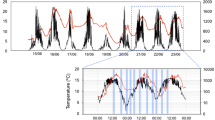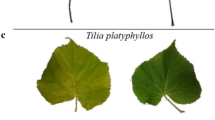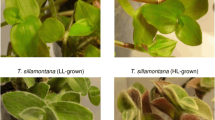Abstract
Plants in the high Arctic are exposed to a 24-h photoperiod for several months. These conditions can be damaging for plants at lower latitudes. When common crops are artificially maintained under continuous light (CL), photosynthetic processes maintain endogenous circadian rhythms, but it is unclear whether plants naturally acclimated to CL also maintain such rhythmicity. Alternatively, Arctic plants have to utilise the favourable conditions during the short Arctic summers. In this study, we evaluate the existence of daily cycles in pigment composition in three Arctic plants in a tundra ecosystem at 78 °N that display examples of different growth forms: the bryophyte Polytrichum hyperboreum, the herb Bistorta vivipara and the dwarf shrub Salix polaris. Changes in pigment composition are excellent indicators of the restructuring of the light-harvesting apparatus. Most pigment parameters analysed did not show any consistent pattern of variation between subjective noon and midnight. P. hyperboreum had the highest level of rhythmicity, while S. polaris was the most stable. Despite these subtle changes, the primary effects observed were induced by light and its effect on the de-epoxidation state of the xanthophyll cycle pigments (AZ/VAZ). Both short- and long-term adjustments of the AZ/VAZ correlated with changes in photochemical efficiency (ΦPSII). When the plants were artificially darkened during the night, it became evident that the midnight sun prevents the complete relaxation of the xanthophyll cycle. These results indicate that light is the primary driver of photochemical efficiency in Arctic plants, and consequently, photosynthesis is not completely interrupted at night.




Similar content being viewed by others
References
Aoki S, Kato S, Ichikawa K, Shimizu M (2004) Circadian expression of the PpLhcb2 gene encoding a major light-harvesting chlorophyll a/b-binding protein in the moss Physcomitrella patens. Plant Cell Physiol 45:68–76
Aro EM, Valanne N (1979) Effect of continous light on CO2 fixation and chloroplast structure of the mosses Pleurozium schreberi and Ceratodon purpureus. Physiol Plant 45:460–466
Barták M, Váczi P, Hájek J (2012) Photosynthetic activity in three vascular species of Spitsbergen vegetation during summer season in response to microclimate. Pol Polar Res 33:443–462
Bell-Pedersen D, Cassone VM, Earnest DJ, Golden SS, Hardin PE, Thomas TL, Zoran MJ (2005) Circadian rhythms from multiple oscillators: lessons from diverse organisms. Nat Rev Genet 6:544–556
Busheva M, Garab G, Liker E, Toth Z, Szell M, Nagy F (1991) Diurnal fluctuations in the content and functional properties of the light harvesting chlorophyll a/b complex in thylakoid membranes. Plant Physiol 95:997–1003
Cazzaniga S, Li Z, Niyogi KK, Bassi R, Dall'Osto L (2012) The Arabidopsis szl1 mutant reveals a critical role of β-carotene in photosystem I photoprotection. Plant Physiol 159:1745–1758
Cela J, Arrom L, Munné-Bosch S (2009) Diurnal changes in photosystem II photochemistry, photoprotective compounds and stress-related phytohormones in the CAM plant, Aptenia cordifolia. Plant Sci 177:404–410
Covington MF, Maloof JN, Straume M, Kay SA, Harmer SL (2008) Global transcriptome analysis reveals circadian regulation of key pathways in plant growth and development. Genome Biol 9:R130
Daylight hours explorer. Astronomy Education at the University of Nebraska-Lincoln. https://astro.unl.edu/classaction/animations/coordsmotion/daylighthoursexplorer.html. Accessed: 7 November, 2017.
Demers DA, Gosselin A (2002) Growing greenhouse tomato and sweet pepper under supplemental lighting: optimal photoperiod, negative effects of long photoperiod and their causes. Acta Hort 580:83–88
Demmig-Adams B, Adams WW (1996) The role of xanthophyll cycle carotenoids in the protection of photosynthesis. Trends Plant Sci 1:21–26
Elbert W, Weber B, Burrows S, Steinkamp J, Büdel B, Andreae MO, Pöschl U (2002) Contribution of cryptogamic covers to the global cycles of carbon and nitrogen. Nat Geosci 5:459–462
Equiza MA, Day ME, Jagels R, Li X (2006) Photosynthetic downregulation in the conifer Metasequioa glyptostroboides growing under continuous light: the significance of carbohydrate sinks and paleoecophysiological implications. Can J Bot 84:1453–1461
Esteban R, Barrutia O, Artetxe U, Fernández-Marín B, Hernández A, García-Plazaola JI (2015) Internal and external factors affecting photosynthetic pigment composition in plants: A meta-analytical approach. New Phytol 206:266–280
Fernández-Marín B, Atherton J, Olascoaga B, Kolari P, Porcar-Castell A, García-Plazaola JI (2018a) When the sun never sets: daily changes in pigment composition in three subarctic woody plants during the summer solstice. Trees 32:615–630
Fernández-Marín B, García-Plazaola JI, Hernández A, Esteban R (2018b) Plant photosynthetic pigments: methods and tricks for correct quantification and identification. In: Sánchez-Moreiras AM, Reigosa MJ (eds) Advances in plant ecophysiology techniques. Springer, Berlin, pp 29–50
Formaggio E, Cinque G, Bassi R (2001) Functional architecture of the major light-harvesting complex from higher plants. J Mol Biol 314:1157–1166
Fukushima A, Kusano M, Nakamichi N, Kobayasho M, Hayashi N, Sakakibara H, Mizuno T, Saito K (2009) Impact of clock-associated Arabidopsis pseudo-response regulators in metabolic coordination. Proc Natl Acad Sci USA 106:7251–7256
García-Plazaola JI, Becerril JM (1999) A rapid HPLC method to measure lipophilic antioxidants in stressed plants: simultaneous determination of carotenoids and tocopherols. Phytochem Anal 10:307–313
García-Plazaola JI, Becerril JM, Hernández A, Niinemets U, Kollist H (2004) Acclimation of antioxidant pools to the light environment in a natural forest canopy. New Phytol 163:87–97
García-Plazaola JI, Fernández-Marín B, Ferrio JP, Alday JG, Hoch G, Landais D, Milcu A, Tissue DT, Voltas J, Gessler A, Roy J, Resco de Dios V (2017) Endogenous circadian rhythms in pigment composition induce changes in photochemical efficiency in plant canopies. Plant Cell Environ 40:1153–1162
Gebauer RLE, Reynolds JF, Tenhunen JD (1998) Diurnal patterns of CO2 and H2O exchange of the Arctic sedges Eriophorum angustifolium and E. variegatum (Cyperaceae). Am J Bot 85:592–599
Harmer SL, Hogenesch JB, Straume M, Chang HS, Han B, Zhu T, Wang X, Kreps JA, Kay SA (2000) Orchestated transcription of key pathways in Arabidopsis by the circadian clock. Science 290:2110–2113
Hennessey T, Freeden A, Field C (1993) Environmental effects on circadian rhythms in photosynthesis and stomatal opening. Planta 189:369–376
Hotta CT, Gardner MJ, Hubbard KE, Baek SJ, Dalchau N, Suhita D, Dodd AN, Webb AAR (2007) Modulation of environmental responses of plants by circadian clocks. Plant Cell Environ 30:333–349
Jones HG, Demmers-Deck HHWM (1999) Photoinhibition as a factor in altitudinal or latitudinal limits of species. Phyton 39:91–98
Khan S, Rowe SC, Harmon FG (2010) Coordination of the maize transcriptome by a conserved circadian clock. BMC Plant Biol 10:126
Korhonen P, Kallio P (1987) The effect of different night conditions on the CO2 fixation in a lichen Xanthoria parietina. Photosynth Res 12:3–11
Krause-Jensen D, Marbà N, Sanz-Martin M, Hendriks IE, Thyrring J, Carstensen J, Sejr MK, Duarte CM (2016) Long photoperiods sustain high pH in Arctic kelp forests. Sci Adv 2:e1501938
Kromdijk J, Głowacka K, Leonelli L, Gabilly ST, Iwai M, Niyogi KK, Long SP (2016) Improving photosynthesis and crop productivity by accelerating recovery from photoprotection. Science 354:857–861
Lloyd CR (2001) The measurement and modelling of the carbon dioxide exchange at a high Arctic site in Svalbard. Glob Change Biol 7:405–426
Loriaux SD, Avenson TJ, Welles JM, Mcdermitt DK, Eckles RD, Riensche B, Genty B (2013) Closing in on maximum yield of chlorophyll fluorescence using a single multiphase flash of sub-saturating intensity. Plant Cell Environ 36:1755–1770
Lu W, Meng Q-J, Tyler NJC, Stokkan KA, Loudon SI (2010) A circadian clock is not required in an Arctic mammal. Curr Biol 20:533–537
Magney TS, Logan BA, Reblin JS, Boelman NT, Eitel JUH, Greaves HE, Griffin KL, Prager CM, Vierling LA (2017) Xanthophyll cycle activity in two prominent Arctic shrub species. Arct Antarct Alp Res 49:277–289
Marchand FL, Mertens S, Kockelbergh F, Beyens L, Nus I (2005) Performance of High Arctic tundra plants improved during but deteriorated after exposure to a simulated extreme temperature event. Glob Change Biol 11:2078–2089
Marschall M, Proctor MCF (2004) Are bryophytes shade plants? Photosynthetic light responses and proportions of chlorophyll a, chlorophyll b and total carotenoids. Ann Bot 94:593–603
Mayer W (1966) Besonderheiten der circadianen rhythmic bei pflanzen verschiedener geographischer breiten. Planta 70:237–256
Muraoka H, Noda H, Uchida M, Ohtsuka T, Koizumi H, Nakatsubi T (2008) Photosynthetic characteristics and biomass distribution of the dominant vascular plant species in a high Arctic tundra ecosystem, Ny-Ålesund, Svalbard: implications for their role in ecosystem carbon gain. J Plant Res 121:137–145
Noordally ZB, Ishii K, Atkins KA, Wetherill SJ, Kusakina J, Walton AJ, Kato M, Azuma M, Tanaka K, Hanaoka M, Dodd AN (2013) Circadian control of chloroplast transcription by a nuclear-encoded timing signal. Science 339:1316–1319
Nordstroem C, Soegaard H, Christensen TR, Friborg T, Hansen BU (2001) Seasonal carbon dioxide balance and respiration of a high−Arctic fen ecosystem in NE−Greenland. Theor Appl Climatol 70:149–166
Pan WJ, Wang X, Deng YR, Li JH, Chen W, Chiang JY, Yang JB, Zheng L (2015) Nondestructive and intuitive determination of circadian chlorophyll rhythms in soybean leaves using multispectral imaging. Sci Rep 5:11108
Patankar R, Mortazavi B, Oberbauer SF, Starr G (2013) Diurnal patterns of gas-exchange and metabolic pools in tundra plants during three phases of the Arctic growing season. Ecol Evol 3:375–388
Pfündel E (1998) Estimating the contribution of Photosystem I to total leaf chlorophyll fluorescence. Photosynth Res 56:185–195
Qin X, Suga M, Kuang T, Shen JR (2015) Structural basis for energy transfer pathways in the plant PSI-LHCI supercomplex. Science 348:989–995
Resco de Dios V, Gessler A (2017) Circadian regulation of photosynthesis and transpiration from genes to ecosystems. Env Exp Bot 152:37–48
Resco de Dios V, Goulden ML, Ogle K, Richardson AD, Hollinger DY, Davidson EA, Alday JG, Barron-Gafford GA, Carrara A, Kowalski AS, Oechel WC, Reverter BR, Scott RL, Varner RK, Díaz-Sierra R, Moreno JM (2012) Endogenous circadian regulation of carbon dioxide exchange in terrestrial ecosystems. Glob Chang Biol 18:1956–1970
Schmid VHR (2008) Light-harvesting complexes of vascular plants. Cel Mol Life Sci 65:3619–3639
Shmakova NY, Markovskaya EF (2010) Photosynthetic Pigments of Plants and Lichens Inhabiting Arctic Tundra of West Spitsbergen. Russ J Plant Physiol 57:764–769
Tang E, Vincent W (2000) Effects of daylength and temperature on the growth and photosynthesis of an Arctic cyanobacterium, Schizothrix calcicola (Oscillatoriaceae). Eur J Phycol 35:263–272
Tobias M, Niinemets Ü (2010) Acclimation of photosynthetic characteristics of the moss Pleurozium schreberi to among-habitat and within-canopy light gradients. Plant Biol 12:743–754
Uchida M, Kishimoto A, Muraoka H, Nakatsubo T, Kanda H, Koizumi H (2010) Seasonal shift in factors controlling net ecosystem production in a high Arctic terrestrial ecosystem. J Plant Res 123:79–85
Velez-Ramirez AI, van Ieperen W, Vreugdenhil D, Millenaar FM (2011) Plants under continuous light. Trends Plant Sci 16:310–318
Velez-Ramirez AI, van Ieperen W, Vreugdenhil D, Pieter MJA, van Poppel MJA, Heuvelink E, Millenaar FM (2014) A single locus confers tolerance to continuous light and allows substantial yield increase in tomato. Nat Commun 5:4549
Acknowledgements
We want to thank the project funded by the Svalbard Environmental Protection fund (Nr. 16/65); Basque Government (UPV/EHU IT-1018-16); Spanish Ministry of Economy and Competitiveness (MINECO) and the ERDF (FEDER) (CTM2014-53902-C2-1-P and CTM2014-53902-C2-2-P) and Juan de la Cierva-Incorporation fellowship (IJCI-2014-22489 to B.F-M).
Author information
Authors and Affiliations
Corresponding author
Ethics declarations
Conflict of interest
The authors declare that there is no conflict of interest.
Electronic supplementary material
Below is the link to the electronic supplementary material.
300_2019_2463_MOESM1_ESM.tiff
Supplementary file1 (TIFF 9493 kb) Online Resource 1. The high Arctic tundra species studied: Ph: Polytrichum hyperboreum, Sp: Salix polaris, Bv: Bistorta vivipara.
300_2019_2463_MOESM2_ESM.pdf
Supplementary file2 (PDF 65 kb) Online Resource 2. Statistically significant (paired t-test) trends maintained between noon and midnight for the parameters analysed in the three species studied. Each individual/daily cycle (16) is considered to be a replicate.
Rights and permissions
About this article
Cite this article
Fernández-Marín, B., Gago, J., Clemente-Moreno, M.J. et al. Plant pigment cycles in the high-Arctic Spitsbergen. Polar Biol 42, 675–684 (2019). https://doi.org/10.1007/s00300-019-02463-x
Received:
Revised:
Accepted:
Published:
Issue Date:
DOI: https://doi.org/10.1007/s00300-019-02463-x




